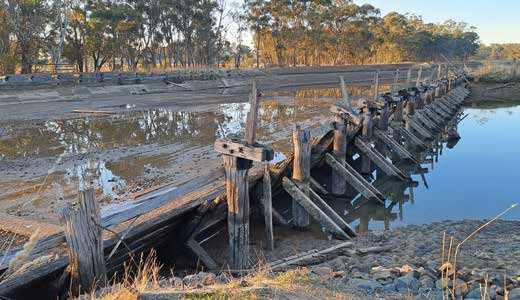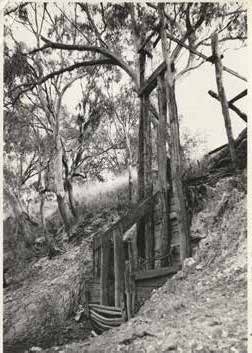Exploring the beginning of irrigation in the Goulburn Valley

At the recent meeting of the Murchison
Historical Society John Dainton from
Shepparton was guest speaker. He has
conducted wide-ranging research and
has compiled a wealth of information
about the beginning of irrigation that
started in Murchison and has developed
to the extensive system that we see today,
throughout Victoria and beyond.
The first public funded irrigation system
supplying many farms started flowing from
a site on the banks of the Goulburn River
near Murchison township in 1885. John
Dainton’s great grandfather built the brick
lined well shaft that is still in existence. It
is not accessible to the public but we were
able to obtain permission, and visited the
site following the talk and afternoon tea. It
is amazing to view the remnants of the works
and to ponder on the skill of the people
involved who had the vision and ability to
build, largely by manual labour, this original
water supply for many farms.
The following is written by Historian
Anne Tyson from Merrigum, to provide
information for those enjoying Irrigation
Tours during locally arranged Heritage Open
Days.
‘The importance of the United Echuca and
Waranga Waterworks Trust’s (UE and WWT)
1885 pumping station on the west bank of
the Goulburn River south of Murchison lies
in the fact that it was the very beginnings of
the first publicly-funded irrigation scheme in
Australia, the Goulburn River Scheme. This
was the earliest of the large-scale irrigation
schemes that would profoundly change the
development of agriculture and patterns of
settlement in Victoria.
The pumping station was the Trust’s
temporary solution to the pent-up demand
for ‘water for the northern plains’ while the
Goulburn Weir, a ‘National’ (State) project,
was being constructed.
From 1882, utilizing government loans,
the Trust had created an extensive system of
channels awaiting both stock and domestic
water and irrigation supply from the promised
gravitational system based on the projected
weir on the Goulburn. Difficult drought
years, which led to an increasingly frenzied
demand for water supply across the north of
the state, and delays in construction of the
Weir, led to the reluctant acceptance of the
pumping station at Murchison.
A brick-lined circular shaft 3.7m in
diameter and 14.5m deep connected with
a timber-lined horizontal tunnel 21m long
which ran from the bottom of the shaft to the
steeply-sloping river bank. A timber sluice
gate, operated by a gun metal screw, with
a grate to prevent debris entering, led from
the river into the tunnel. Two Robison Bros
(South Melbourne) patent 26inch horizontal
centrifugal pumps were fixed in the shaft, as
close as possible to the river water level so as
to maximise efficiency. Each had a delivery
pipe of 838mm in diameter (the brick work
at the top of the shaft reveals the opening
for these pipes). The pumps were driven
by a pair of powerful horizontal compound
engines, with multi-tubular boilers.
The two pumps were capable of delivering
approximately one tonne of water per second
or about 20,000,000 gallons per day. Staff
were stationed with the pumps around the
clock.
The water was discharged to a brick-
lined settling pond before flowing into the
Trust Channel’, which was 137 km long
and 2.5 metres wide. The Channel travelled
to the west, across Gunn’s Swamp (soon to
be deepened and extended to become the
Waranga Basin) on an embankment, and
thence further west to the Campaspe River,
passing south of Lake Cooper. From this,
lesser branch channels ran north or north-
west towards the Murray. The Commissioners
of the Trust, in a phenomenal achievement
(although many of the channels were later
derided as ‘gutters’), had endeavoured to
ensure that no farmer would be more than a
mile and a half from water. Some sections
of the Trust Channel are still used, some
sections can be seen but unused, and some
have been filled in.

Initially the volume was only adequate
to provide stock and domestic supplies. The
pumps first supplied irrigation water in May
1886, a very limited number of applicants
receiving water for up to fifty acres. These
were the pioneer vine and fruit growers at
Ardmona and Mooroopna who were the most
vocal in their demands for irrigation water.
The Goulburn scheme thus preceded
the Chaffeys’ famous private scheme at
Mildura. Huge publicity had been garnered
by the brothers’ entrepreneurial approach, the
audacity of their scheme and the speed of its
realisation, but irrigation from the Murchison
pumps had commenced over a year before the
Mildura scheme, where water was not sent
down the channels until mid-October 1887.
Large-scale irrigation in the Goulburn Valley
and indeed in Australia can be said to date
from May 1886, from the pumping station at
Murchison.
The pumps continued to supply the
western Goulburn Valley until the Weir was
completed in 1891, when they were removed
and sold.
With the construction in 1910 of the East
Goulburn Main Channel servicing the eastern
Goulburn Valley centred on Shepparton, and
the building of the Eildon Weir and Dam
(1915-1929, with subsequent enlargement)
providing a greatly increased volume of
water, the pioneering irrigation scheme that
commenced at the Murchison pump site
became the largest and most productive
of Victoria’s irrigation schemes, the area
described as the Food Bowl of Victoria.’
As the channel water is not currently
flowing it was possible to also see remnants
of a timber structure, flume No. 4 located
south of the Pump Site, which is fully
exposed. A flume is like a bridge or aqueduct
built to allow water, as in this case the Stuart-
Murray Canal, to flow over a creek or natural
drainage depression. This clear view of the
flume was an added bonus to our excursion
that was primarily to view the Pump Site.
Kay Ball,
Murchison & District Historical Society Inc.











